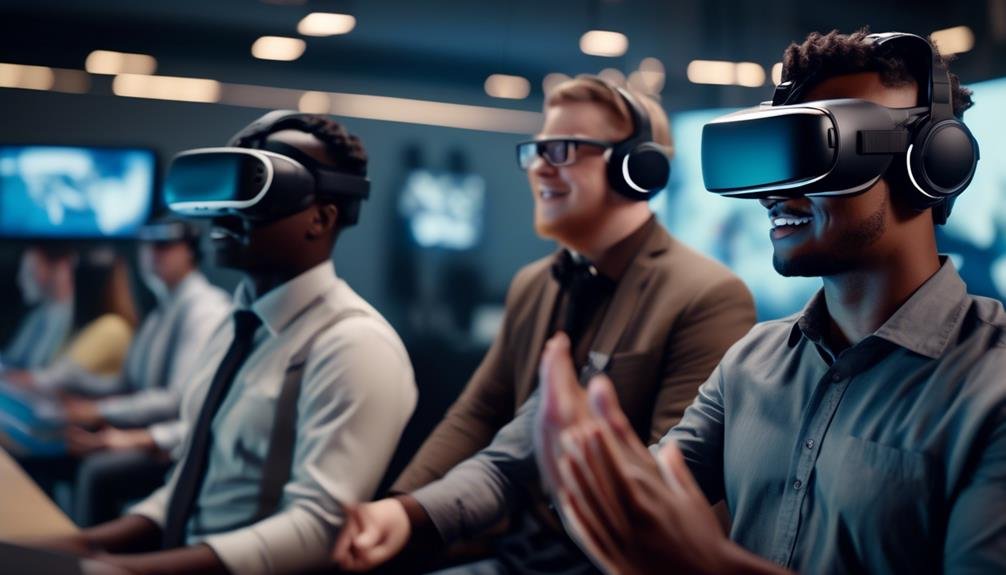Utilizing Gamification in Employee Training
In today's competitive business landscape, companies are constantly seeking innovative ways to enhance employee training and development. One powerful approach that has gained significant traction is the utilization of gamification in employee training. By incorporating game elements and mechanics into the training process, organizations have witnessed a remarkable improvement in employee engagement and learning outcomes.
But what exactly is gamification, and how can it be effectively implemented in the workplace? In this discussion, we will explore the benefits of gamification in training, delve into various gamification strategies, and examine real-life case studies of successful implementation.
So, let's embark on this journey and discover the exciting world of gamified employee training.
Key Takeaways
- Gamification in employee training increases productivity and knowledge retention through the use of game elements like leaderboards and rewards.
- It enhances employee engagement and motivation by creating a more engaging and interactive learning experience.
- Gamification boosts motivation levels through friendly competition, rewards, and recognition.
- It improves learning outcomes by improving knowledge retention, problem-solving skills, and promoting continuous learning.
Benefits of Gamification in Training
Gamification in employee training offers numerous benefits that enhance engagement, improve knowledge retention, and drive overall performance.
One of the key benefits of gamification is its ability to increase productivity. By incorporating game elements such as leaderboards, badges, and rewards, employees are motivated to complete tasks and achieve goals in a timely manner. The competitive nature of gamification fosters a sense of urgency and encourages employees to work efficiently, ultimately leading to increased productivity.
Another important benefit of gamification in employee training is its impact on knowledge retention. Traditional training methods often rely on passive learning, where employees are simply presented with information and expected to remember it. However, gamification makes learning interactive and engaging. By turning training content into a game-like experience, employees are actively involved in the learning process.
This active participation improves their ability to absorb and retain information. The use of quizzes, challenges, and simulations in gamified training programs reinforces learning and helps employees remember key concepts and skills.
Gamification Elements and Mechanics
Incorporating elements and mechanics from popular games, such as leaderboards, badges, and rewards, can enhance the effectiveness of employee training programs. Gamification strategies leverage these elements to create a more engaging and interactive learning experience for employees.
Here are some key gamification elements and mechanics that can be incorporated into employee training programs:
- Leaderboards: Introducing leaderboards allows employees to compare their progress and performance with their peers. This element fosters a sense of competition and encourages employees to strive for improvement.
- Badges: Awarding badges for completing certain tasks or achieving specific milestones adds a sense of accomplishment and recognition. It motivates employees to actively participate and complete training modules.
- Rewards: Implementing rewards, such as virtual currency or tangible incentives, provides employees with a tangible benefit for their efforts. This element increases motivation and encourages active engagement in the training process.
- Progress Tracking: Including progress tracking mechanisms allows employees to visualize their learning journey. This element provides a sense of progression and helps employees understand their strengths and areas for improvement.
Improving Employee Engagement Through Gamification
Employee engagement is a critical factor for the success of any organization.
By incorporating gamification elements into employee training, companies can boost motivation levels and increase engagement.
Games offer a unique and interactive learning experience that can captivate employees and enhance their overall training outcomes.
Boosting Motivation With Games
Boosting motivation in employee training can be achieved through the strategic implementation of engaging and interactive game-based techniques. By incorporating games into training programs, organizations can create an environment that increases productivity and fosters teamwork.
Here are four ways games can boost motivation in employee training:
- Competition: Introducing friendly competition through games can ignite motivation among employees, as they strive to outperform their colleagues and achieve higher scores.
- Rewards and recognition: Offering rewards and recognition to top performers in game-based training can drive motivation by giving employees a sense of accomplishment and validation.
- Progress tracking: Games that allow employees to track their progress and see their improvement over time can boost motivation by providing a visual representation of their growth.
- Collaboration: Group-based games that require employees to work together towards a common goal can foster teamwork and enhance motivation through shared success.
Enhancing Learning Experience
To enhance the learning experience and improve employee engagement, organizations can leverage the power of gamification in their training programs. By incorporating game elements such as points, badges, and leaderboards, organizations can create a more interactive and immersive learning environment. This not only increases employee satisfaction but also improves knowledge retention.
Gamification makes training more engaging by turning it into a fun and interactive experience. Employees are motivated to participate and compete with their peers, which drives them to actively seek knowledge and complete training modules. The use of rewards and recognition further reinforces learning and encourages employees to continue their development.
Furthermore, gamification provides immediate feedback, allowing employees to track their progress and identify areas for improvement. This real-time feedback helps employees stay motivated and engaged, as they can see their growth and accomplishments.
Enhancing Learning Outcomes With Gamified Training
By incorporating gamified training methods, organizations can significantly enhance the overall learning outcomes for their employees. Gamification offers a unique approach to employee training that goes beyond traditional methods, such as lectures or reading materials. It leverages game elements, such as competition, rewards, and challenges, to create an engaging and interactive learning experience.
Here are four ways in which gamified training can enhance learning outcomes:
- Improving knowledge retention: Gamification makes learning more memorable by presenting information in a fun and interactive way. When employees are actively engaged in a game-like environment, they are more likely to retain and recall information effectively.
- Increasing employee motivation: Gamified training taps into employees' intrinsic motivation by providing them with a sense of achievement and progress. By incorporating leaderboards, badges, and rewards, organizations can create a competitive and motivating learning environment that encourages employees to actively participate and strive for success.
- Enhancing problem-solving skills: Games often require players to solve problems or overcome challenges to progress. By incorporating gamified elements into training programs, organizations can help employees develop critical thinking, problem-solving, and decision-making skills that can be applied in real-world scenarios.
- Promoting continuous learning: Gamified training can create a culture of continuous learning within organizations. By providing employees with ongoing challenges and opportunities to level up their skills, organizations can foster a growth mindset and encourage employees to engage in lifelong learning.
Gamification Strategies for Knowledge Retention
In order to maximize knowledge retention, organizations can employ various effective gamification strategies in their employee training programs. By incorporating gamification elements into training modules, organizations can improve retention rates and increase knowledge acquisition among employees.
One strategy is to utilize leaderboards and badges to create a sense of competition and motivation. Employees can earn points or badges for completing training modules or achieving certain milestones. This not only encourages engagement but also provides a visual representation of progress, which can enhance knowledge retention.
Another effective strategy is the use of storytelling and narratives. By creating immersive scenarios and incorporating storytelling elements, employees can better connect with the training material. This helps to improve retention rates by making the content more relatable and memorable.
Additionally, incorporating gamified assessments and quizzes can help reinforce learning and improve knowledge retention. By turning assessments into interactive games or challenges, employees are more likely to actively engage with the content and retain the information for a longer period.
Furthermore, organizations can implement spaced repetition techniques within gamified training programs. This involves revisiting previously learned material at spaced intervals to reinforce knowledge retention. By incorporating gamified elements such as mini-games or quizzes during these review sessions, employees are more likely to remain engaged and retain the information effectively.
Incorporating Gamification Into Onboarding Programs
When it comes to onboarding programs, incorporating gamification can bring numerous benefits.
Gamified onboarding not only enhances employee engagement and motivation but also improves knowledge retention.
Benefits of Gamified Onboarding
The incorporation of gamification into onboarding programs offers numerous benefits for organizations and their new employees. By integrating game elements into the onboarding process, companies can enhance the overall experience and improve productivity among their workforce. Some of the key benefits of gamified onboarding include:
- Increased engagement: Gamification makes the onboarding process more interactive and enjoyable, increasing employee engagement and attention span.
- Enhanced knowledge retention: Through gamified activities, new employees can acquire and retain information more effectively, ensuring a smoother transition into their roles.
- Foster teamwork and collaboration: Gamified onboarding encourages employees to work together towards common goals, fostering a sense of teamwork and collaboration from the start.
- Boosted job satisfaction: The fun and immersive nature of gamification can lead to increased job satisfaction, as employees feel more motivated and rewarded for their efforts.
Implementing Gamification Techniques
To effectively incorporate gamification into onboarding programs, organizations must carefully design and implement interactive game elements that seamlessly integrate with the training process. This requires understanding the gamification challenges and ensuring a successful gamification implementation.
One way to achieve this is by creating a game-based orientation program that introduces new employees to the company culture, values, and policies. This can be done through interactive quizzes, challenges, and simulations that allow employees to learn and apply their knowledge in a fun and engaging way.
Another approach is to incorporate leaderboards and badges into the onboarding process. By tracking and rewarding progress, employees are motivated to complete training modules and achieve higher scores, fostering healthy competition and a sense of achievement.
By incorporating gamification techniques into onboarding programs, organizations can enhance employee engagement, improve knowledge retention, and create a positive learning experience that sets the stage for future success.
| Gamification Challenges | Gamification Implementation | Benefits |
|---|---|---|
| Lack of clear objectives | Define clear objectives and goals for gamified onboarding programs | Increased employee engagement |
| Limited resources | Utilize online platforms and tools to design and implement gamified elements | Improved knowledge retention |
| Resistance to change | Communicate the benefits of gamification and provide training and support | Enhanced onboarding experience |
| Lack of employee buy-in | Involve employees in the design process and gather feedback to ensure relevance and effectiveness | Healthy competition and motivation |
| Difficulty in measuring ROI | Track employee performance and progress through analytics and metrics | Improved onboarding outcomes |
Gamification Techniques for Skill Development
Effective gamification techniques can greatly enhance skill development in employee training, fostering engagement, motivation, and knowledge retention. By incorporating gamification elements into skill development programs, organizations can create a more interactive and immersive learning experience for their employees.
Here are some gamification techniques that can be used for skill development:
- Leaderboards: Implementing leaderboards can promote healthy competition among employees, encouraging them to strive for excellence and improve their skills.
- Achievement badges: Awarding badges for accomplishing specific milestones or mastering certain skills can provide a sense of accomplishment and motivate employees to continue their skill development journey.
- Progress tracking: Using progress bars or visual representations of progress can help employees see their improvement over time, motivating them to continue practicing and developing their skills.
- Challenges and quests: Designing challenges and quests that require employees to apply their newly acquired skills in real-life scenarios can enhance their learning experience and reinforce their skill development.
When it comes to team building, gamification techniques such as team-based challenges and competitions can foster collaboration, communication, and teamwork among employees. Similarly, for customer service training, gamification strategies like role-playing exercises and virtual simulations can help employees practice their customer service skills in a safe and controlled environment.
Measuring the Effectiveness of Gamified Training
When it comes to measuring the effectiveness of gamified training, it is important to establish clear metrics for assessing the impact on employee performance. These metrics can include completion rates, knowledge retention, and skill improvement.
Metrics for Assessing Gamification
Using objective and measurable metrics is essential for accurately assessing the effectiveness of gamified training in employee development. By measuring gamification success and analyzing user engagement, organizations can determine the impact of gamified training programs on their workforce. Here are some key metrics to consider:
- Completion rates: Tracking the percentage of employees who complete the gamified training helps assess the overall engagement and effectiveness of the program.
- Time spent: Monitoring the amount of time employees spend on the training activities provides insights into their level of engagement and commitment.
- Knowledge retention: Assessing the retention of information learned through the gamified training helps evaluate its long-term impact on employee performance.
- Performance improvement: Measuring the improvement in key performance indicators (KPIs) before and after the training enables organizations to determine the effectiveness of gamification in driving desired outcomes.
Impact on Employee Performance
To measure the impact of gamified training on employee performance, organizations must analyze the tangible outcomes and behavioral changes resulting from the implementation of gamification strategies.
One key aspect to consider is employee motivation. Gamification can enhance employee motivation by incorporating elements such as rewards, leaderboards, and badges, which create a sense of achievement and competition among employees. This increased motivation can lead to improved performance and productivity.
Additionally, performance evaluation is crucial to assess the effectiveness of gamified training. Organizations can track metrics such as completion rates, time to proficiency, and performance improvement to measure the impact of gamification on employee performance.
Best Practices for Implementing Gamification
Implementing gamification in employee training requires careful planning and consideration of best practices to ensure maximum effectiveness and engagement. Here are some best practices to follow when implementing gamification in employee training:
- Set clear objectives: Clearly define the goals and objectives of the training program and how gamification will help achieve them. This will ensure that the gamified elements are aligned with the desired outcomes.
- Understand the audience: Take the time to understand the needs, preferences, and learning styles of your employees. This will help in designing a gamified training program that resonates with them and keeps them engaged.
- Provide meaningful rewards: Offer rewards that are meaningful and relevant to the employees. This could include badges, points, or even real-world incentives. The rewards should motivate and encourage employees to actively participate and progress in the training program.
- Continuously evaluate and improve: Regularly analyze the data and feedback from the gamified training program to measure its effectiveness. Conduct a gamification ROI analysis to determine whether the program is delivering the desired results and make necessary adjustments to improve its impact.
Case Studies: Successful Gamification in Employee Training
Successful gamification in employee training has been proven to increase engagement, knowledge retention, and overall effectiveness of the training programs. Many organizations have successfully implemented gamification strategies to enhance their employee training efforts.
Let's explore some case studies that showcase the successful implementation of gamification in employee training.
One such case study is from Deloitte, a global professional services firm. They used gamification to train their employees on complex business processes and procedures. By incorporating game elements such as points, badges, and leaderboards, Deloitte was able to create a competitive and engaging learning environment. The results were impressive, with a significant increase in employee participation and improved knowledge retention.
Another successful case study comes from Microsoft. They implemented a gamified training program called 'The Challenger Sales Game,' which aimed to improve the sales skills of their employees. The game simulated real-life sales scenarios and rewarded employees for making strategic decisions and closing deals. The program not only increased employee engagement but also resulted in a 10% increase in sales revenue.
These case studies highlight the power of gamification in employee training. By leveraging game mechanics and incorporating elements of competition and rewards, organizations can create immersive learning experiences that drive engagement, enhance knowledge retention, and ultimately improve overall training effectiveness.
Conclusion
In conclusion, gamification in employee training offers numerous benefits, including improved engagement, enhanced learning outcomes, and increased knowledge retention.
By incorporating gamified elements and mechanics, organizations can create interactive and enjoyable training experiences.
Implementing best practices and measuring the effectiveness of gamified training can further optimize the learning process.
Through successful case studies, it is evident that gamification is an effective strategy for developing skills and fostering a motivated workforce.
Embrace gamification and unlock the potential of your employees' learning journey.







